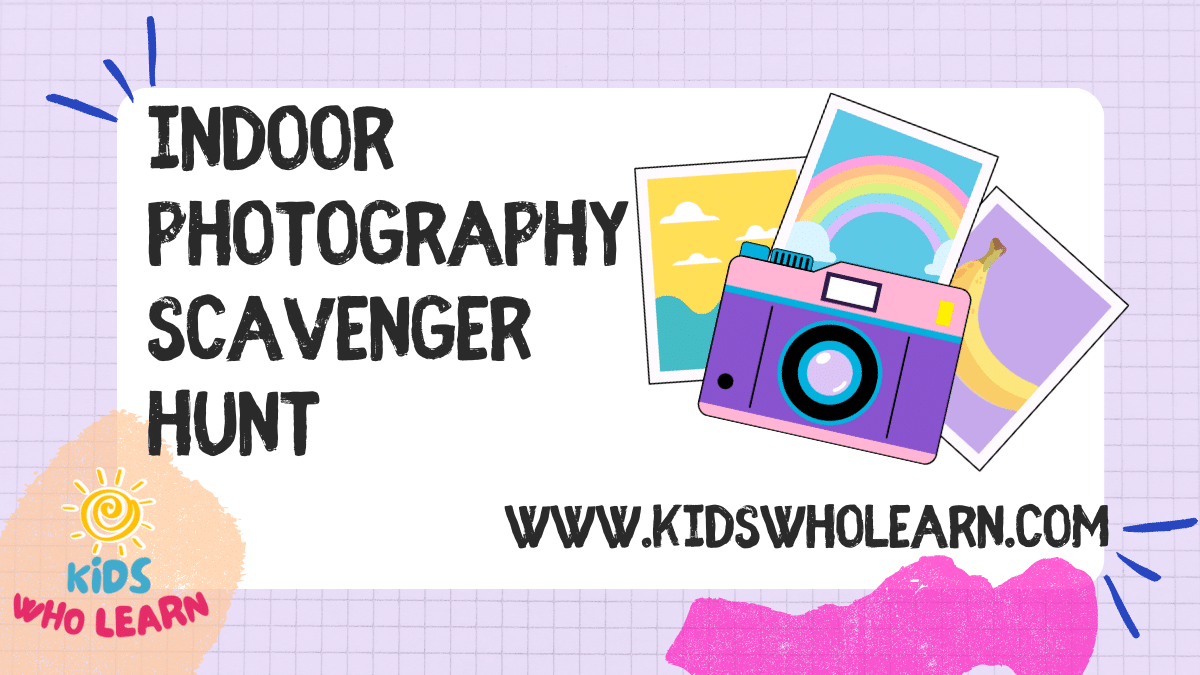Indoor photography scavenger hunts are a creative and engaging way to hone your photography skills while having fun. Whether you’re a seasoned photographer or a hobbyist, these hunts challenge you to capture specific items or scenes within a confined space. Participants must get creative, using their environment to find and photograph a list of predetermined subjects, which can range from simple household objects to more abstract concepts.
Organizing an indoor photography scavenger hunt requires thoughtful planning. Deciding on a theme and crafting challenges that cater to various skill levels can ensure inclusiveness and engagement among participants. Themes can be as broad as “colors” or as specific as “childhood memories.” Once the list is set, photographers embark on their visual treasure hunt. As they explore indoor environments, the emphasis is not just on checking items off a list but also on capturing these subjects with a unique perspective and creative flair.
Key Takeaways
- A photography scavenger hunt sharpens your observation and photography skills.
- Thorough planning enhances the engagement and enjoyment of participants.
- Participants should prioritize creativity and unique perspectives when capturing photos.
Fundamentals of Indoor Photography Scavenger Hunts
Indoor photography scavenger hunts represent a dynamic activity that combines the thrill of discovery with the art of photography. These hunts inspire creativity and interactive engagement within various indoor environments.
Understanding Scavenger Hunts
A scavenger hunt is a game in which you solve riddles or clues to find items. With indoor photography scavenger hunts, the objective is not just to find the items but to capture them with your camera. Traditional scavenger hunts involve physically collecting items, but in this creative twist, the proof of your find lies in a photographic image. This activity can be a solo challenge or a team effort, promoting collaboration and offering a unique way to hone your photography skills.
Essentials of Indoor Photography
Indoor settings provide specific challenges and opportunities for photography. You will need to manage artificial light sources and might need to adjust your camera’s zoom to get the best shot of your scavenger hunt items. Understand your camera’s settings, such as aperture, shutter speed, and ISO to overcome these challenges. Also, familiarize yourself with different photographic compositions to make your captured images as compelling as the hunt itself.
Types of Photo Scavenger Hunts
There are various formats of photo scavenger hunts, tailored for teams or individuals. Some hunts might use a scavenger hunt app to provide clues and organize photos, adding a digital element to the activity. Examples of hunt types include:
- Theme-based hunts, where each photo must adhere to a set theme or concept.
- Skill challenges, which push you to use or develop a certain photography technique.
- Riddle hunts, where each clue is a riddle you must solve to find your next subject.
To get the best out of the hunt, choose a type that matches your photographic interest and level of expertise. Whether aiming to sharpen your eye for detail or just having fun, the adventure of an indoor photography scavenger hunt is a game that challenges both your intellect and artistic abilities.
Planning Your Photo Scavenger Hunt
Successful photo scavenger hunts revolve around meticulous planning, which involves selecting an appropriate location, establishing the game rules, and crafting a well-thought-out list of photographic challenges.
Choosing the Location
When picking a location for your photo scavenger hunt, consider places with multiple points of interest such as malls, museums, or college campuses. Each venue provides unique opportunities and challenges, so select one that compliments the skill level and mobility of participants. For a controlled environment, free from weather considerations, an indoor venue like a conference center may be ideal.
Setting the Rules
Rules are fundamental to organizing a successful competition. Clearly define the start and end times to maintain a fair time limit for all players. Decide on whether participants can work in teams or individually, and dictate what forms of photography are permissible. Rules should be explicitly conveyed to thwart any confusion during the hunt.
Creating the Scavenger Hunt List
Your photo scavenger hunt list should include a variety of tasks that prompt creativity and observation. Construct a list of items featuring identifiable landmarks and intriguing objects within the chosen location to photograph. Consider using a table format to present the list:
| Item No. | Photography Task | Points |
|---|---|---|
| 1 | A reflection in a store window | 10 |
| 2 | Interactive museum exhibit | 20 |
| 3 | Architectural detail | 15 |
| 4 | Group of strangers | 25 |
Tailor the complexity of tasks to the participants’ skill levels to keep the competition engaging.
Themes and Challenges
When you embark on an Indoor Photography Scavenger Hunt, selecting engrossing themes and crafting unique challenges provides the backbone for a memorable and educational experience. This empowers team building, bolsters creativity, and heightens interaction among participants.
Selecting Themes
Your choice of themes is pivotal for setting the tone and direction of the scavenger hunt. A well-chosen theme can resonate with the event’s ambiance, whether it’s a conference or a casual gathering. Here are a few specific themes to consider:
- Nature Indoors: Capture elements of nature that can be found within the confines of an indoor setting.
- The Color Spectrum: Focus on finding objects that represent a spectrum of colors.
- Architectural Wonders: Seek out interesting architectural details within a building.
- Reflections and Shadows: Challenge participants to find unique interplays of light and shadow.
- Historical Artifacts: Incorporate a tradition by having participants photograph objects with historical significance present indoors.
Crafting Unique Challenges
Challenges should encourage participants to think outside the box and learn new photography techniques while they search for their subjects. Each challenge should infuse an element of complexity without being prohibitively difficult. Here are examples of challenges to introduce:
- Macro Mystery: Take extreme close-up photos to capture details often overlooked.
- Perspective Shift: Photograph common items from new and unusual angles.
- Contrast and Composition: Use the contrasts in the indoor environment to create striking compositions.
- Story Sequences: Create a narrative using a series of photos that tell a story.
- Clue-Based Quests: Solve riddles to find the next photographic target.
In selecting your themes and challenges, maintain a balance that fosters learning and interaction, while also keeping the activity enjoyable and conducive to team building.
Execution and Participation
When initiating an indoor photography scavenger hunt, your focus should be on smooth execution and engaging participation. By ensuring everything from the kick-off to team interaction and safety is carefully considered, you can create an enjoyable experience for all participants.
Kicking Off the Event
To start your indoor photography scavenger hunt, gather all teams in a common space where you can explain the rules and objectives. Ensure each team understands the photo scavenger hunt challenges and has a list of items or themes to capture, such as a portrait against a creative backdrop or a unique angle of everyday objects. Begin with an energizing introduction that sets a positive tone for the activity.
Facilitating Team Interaction
Promote dynamic interaction among team members by encouraging them to strategize and communicate. Providing a digital platform or designated space for teams to discuss their plan can lead to more effective collaboration. Use clear communication channels to enhance the group experience, vital for colleagues and employee team-building activities.
- Communication Tools:
- Instant messaging apps
- Walkie-talkies (for larger spaces)
- Physical meeting points
Guidelines for Photography
Photography in an indoor scavenger hunt requires specific guidelines to ensure fairness and creativity. Encourage participants to be inventive with their photos—taking pictures of shadows, reflections, or small details that represent larger ideas.
- Photo Challenge Examples:
- A whimsical interpretation of space.
- Capturing the essence of ‘sunset’ indoors.
- An abstract cityscape using items found indoors.
Remember to remind teams that the quality of photos is more important than quantity, and to provide tips on lighting and composition for creating stunning images indoors.
Safety and Courtesy Considerations
Safety and respect are paramount during the scavenger hunt. Emphasize to participants that while moving around indoors, they should be aware of their surroundings and courteous to non-participants.
- Safety Reminders:
- Avoid obstructing pathways.
- Handle props and equipment with care.
By setting clear expectations around behavior, you can maintain a safe and respectful environment conducive to enjoyable participation.
Documenting and Sharing the Experience
In an indoor photography scavenger hunt, capturing the moments is just the beginning. It’s crucial to review and share your photos, acknowledge winners through points and prizes, and engage in post-event reflection to maximize the learning and enjoyment from the experience.
Reviewing and Sharing Photos
After the hunt, it’s time to share your captures. Organize your images and any video footage for an easy reviewing process. Displaying them on a large screen can give everyone an epic view and spur interaction. Create a shared online album or use a conference platform where participants can upload their pictures. Encouraging participants to talk about their photos can enhance the learning aspect of the event.
- Upload Location: Central online album or digital conference room
- Format: JPEG, PNG for images, MP4 for video
- Sharing: Enable permissions for all participants to view and upload
Awarding Points and Prizes
Assigning points to each photo based on criteria such as creativity, relevance, and quality turns the event into a competition. Use a point system to score each submission and determine the winners. Presenting prizes can be a surprise element that adds excitement. Ensure there’s a clear scoring system and announce the winners in an award ceremony to celebrate their skills.
- Point System Example:
- Creativity: 1-5 points
- Relevance: 1-5 points
- Quality: 1-5 points
- Prizes: Trophies, certificates, photography equipment
Post-Event Reflection
Your scavenger hunt is also an exercise in reflection. Hold a session where participants can discuss what they learned and how they interacted with the space and each other. This process reinforces the educational value and cements the event as a positive experience.
- Topics for Reflection:
- Techniques learned
- Challenges faced
- Most enjoyable aspects
Frequently Asked Questions
Before starting your indoor photography scavenger hunt, carefully consider the strategies for creating it, designing challenges and entertaining tasks, developing clues, structuring the event, and determining an optimal duration to keep participants engaged.
What are the best strategies for creating a printable indoor photography scavenger hunt?
When creating a printable indoor photography scavenger hunt, focus on variety in your challenges to cater to different skill levels. Use clear images and readable fonts for your printouts. Ensure that each task is clear, and consider including a mix of specific photo objectives and more open-ended challenges to spark creativity.
How can I design an entertaining and challenging indoor photography scavenger hunt for adults?
To design an indoor photography scavenger hunt for adults, incorporate tasks that require problem-solving or clever interpretation. Include references to popular culture, use puns or riddles, and create scenarios that require teamwork. Make sure the tasks are age-appropriate and that they might push participants slightly out of their comfort zone for added excitement.
What methods are effective for developing clues for an indoor photography scavenger hunt?
Effective methods for developing clues include using word puzzles, rhymes, or riddles that lead to the subject of the photo. Integrate visual clues or parts of images that connect to the broader scene they must capture. Ensure that your clues are neither too obscure nor too easy to maintain the hunt’s intrigue.
Can you provide guidelines on structuring and facilitating a photo scavenger hunt?
Start with a clear and concise brief outlining the rules and objectives. Provide each participant or team with a checklist of photo challenges. Facilitate the scavenger hunt by setting a start and end point, keeping time, and making yourself available to clarify questions. After completion, gather participants for a showcase of the photos to share the experience and declare the winner.
What are the steps to create an engaging and interactive scavenger hunt?
To create an engaging and interactive scavenger hunt, list your objectives and decide on a theme. Develop a series of photo challenges related to the theme. Mix individual and team tasks to encourage interaction. Use technology such as smartphone cameras and social media for sharing results. Provide instant feedback or rewards after each challenge to maintain engagement.
What is an appropriate duration for a photo scavenger hunt to maintain interest and excitement?
An indoor photo scavenger hunt should last between one to two hours. This timeframe allows enough opportunity to explore, photograph, and solve challenges without fatigue setting in. Adjust the duration based on the complexity of tasks and the size of the venue to ensure a brisk pace and sustained interest.










